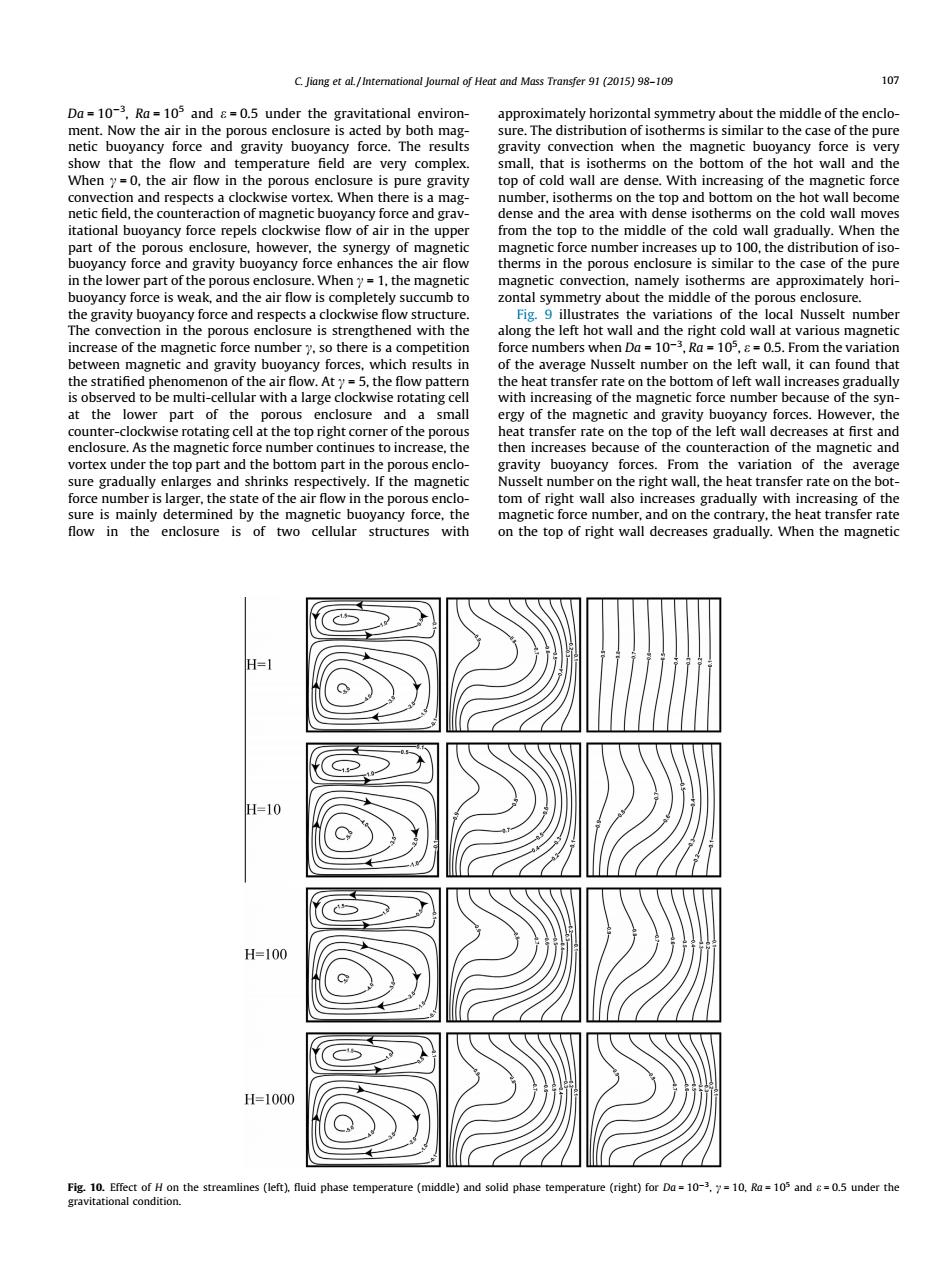正在加载图片...

C.Jiang et al.Int onal jo Het and Mass Transfer 91 (2015)9-109 Da=10-3 Ra=105 and =05 unde the middle o to the case of the pure and temperature feld are very comple and bottom n the ho wall be om nthelowerpirtoi sorce nmDer increasem namely msare approximately the gravity buoyancy force and respectsa clockwi e flo th iatio of the loc Nusselt numbe ncrease of the mag ic force number .so there is a numbers when.From the variatio andgTaCAC the tl ed to be m h f th otati corn r of the po te on the of the left wa ases at fir of th ortex unde the vancy force the number is l ate of the air flo in the right of th on the top of right wall dece H-10 H=100 H=100 the sre (eft).fluid phas ture (middle)and solid phase re (right)for Da=10-7=10.Ra=10 and =05 under the Da = 103 , Ra = 105 and e = 0.5 under the gravitational environment. Now the air in the porous enclosure is acted by both magnetic buoyancy force and gravity buoyancy force. The results show that the flow and temperature field are very complex. When c = 0, the air flow in the porous enclosure is pure gravity convection and respects a clockwise vortex. When there is a magnetic field, the counteraction of magnetic buoyancy force and gravitational buoyancy force repels clockwise flow of air in the upper part of the porous enclosure, however, the synergy of magnetic buoyancy force and gravity buoyancy force enhances the air flow in the lower part of the porous enclosure. When c = 1, the magnetic buoyancy force is weak, and the air flow is completely succumb to the gravity buoyancy force and respects a clockwise flow structure. The convection in the porous enclosure is strengthened with the increase of the magnetic force number c, so there is a competition between magnetic and gravity buoyancy forces, which results in the stratified phenomenon of the air flow. At c = 5, the flow pattern is observed to be multi-cellular with a large clockwise rotating cell at the lower part of the porous enclosure and a small counter-clockwise rotating cell at the top right corner of the porous enclosure. As the magnetic force number continues to increase, the vortex under the top part and the bottom part in the porous enclosure gradually enlarges and shrinks respectively. If the magnetic force number is larger, the state of the air flow in the porous enclosure is mainly determined by the magnetic buoyancy force, the flow in the enclosure is of two cellular structures with approximately horizontal symmetry about the middle of the enclosure. The distribution of isotherms is similar to the case of the pure gravity convection when the magnetic buoyancy force is very small, that is isotherms on the bottom of the hot wall and the top of cold wall are dense. With increasing of the magnetic force number, isotherms on the top and bottom on the hot wall become dense and the area with dense isotherms on the cold wall moves from the top to the middle of the cold wall gradually. When the magnetic force number increases up to 100, the distribution of isotherms in the porous enclosure is similar to the case of the pure magnetic convection, namely isotherms are approximately horizontal symmetry about the middle of the porous enclosure. Fig. 9 illustrates the variations of the local Nusselt number along the left hot wall and the right cold wall at various magnetic force numbers when Da = 103 , Ra = 105 , e = 0.5. From the variation of the average Nusselt number on the left wall, it can found that the heat transfer rate on the bottom of left wall increases gradually with increasing of the magnetic force number because of the synergy of the magnetic and gravity buoyancy forces. However, the heat transfer rate on the top of the left wall decreases at first and then increases because of the counteraction of the magnetic and gravity buoyancy forces. From the variation of the average Nusselt number on the right wall, the heat transfer rate on the bottom of right wall also increases gradually with increasing of the magnetic force number, and on the contrary, the heat transfer rate on the top of right wall decreases gradually. When the magnetic Fig. 10. Effect of H on the streamlines (left), fluid phase temperature (middle) and solid phase temperature (right) for Da = 103 , c = 10, Ra = 105 and e = 0.5 under the gravitational condition. C. Jiang et al. / International Journal of Heat and Mass Transfer 91 (2015) 98–109 107���